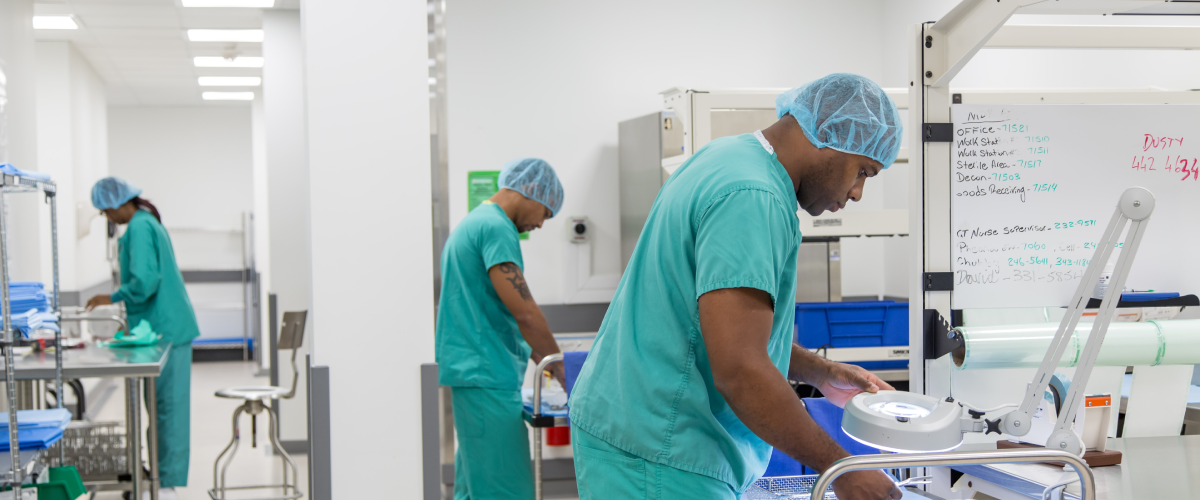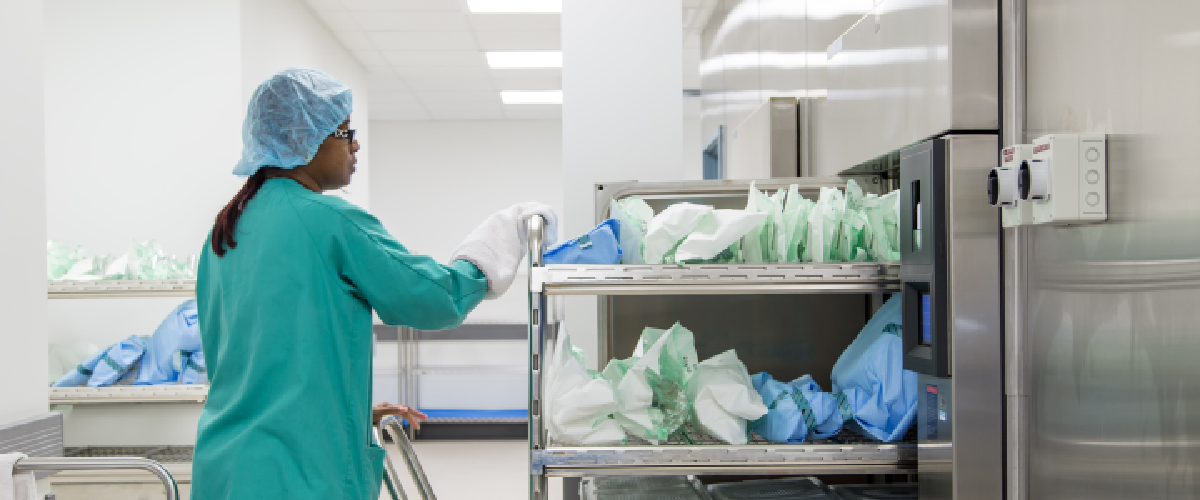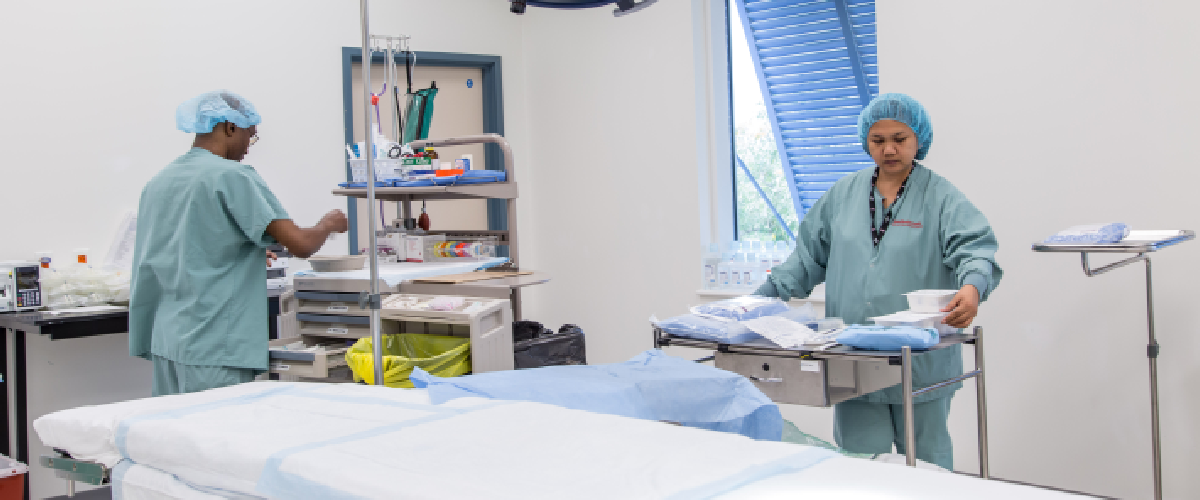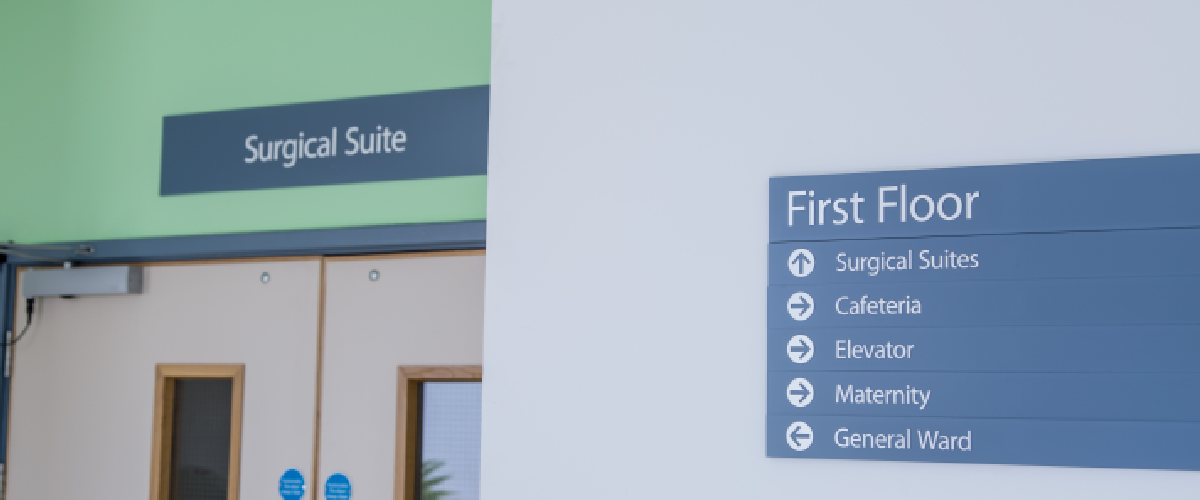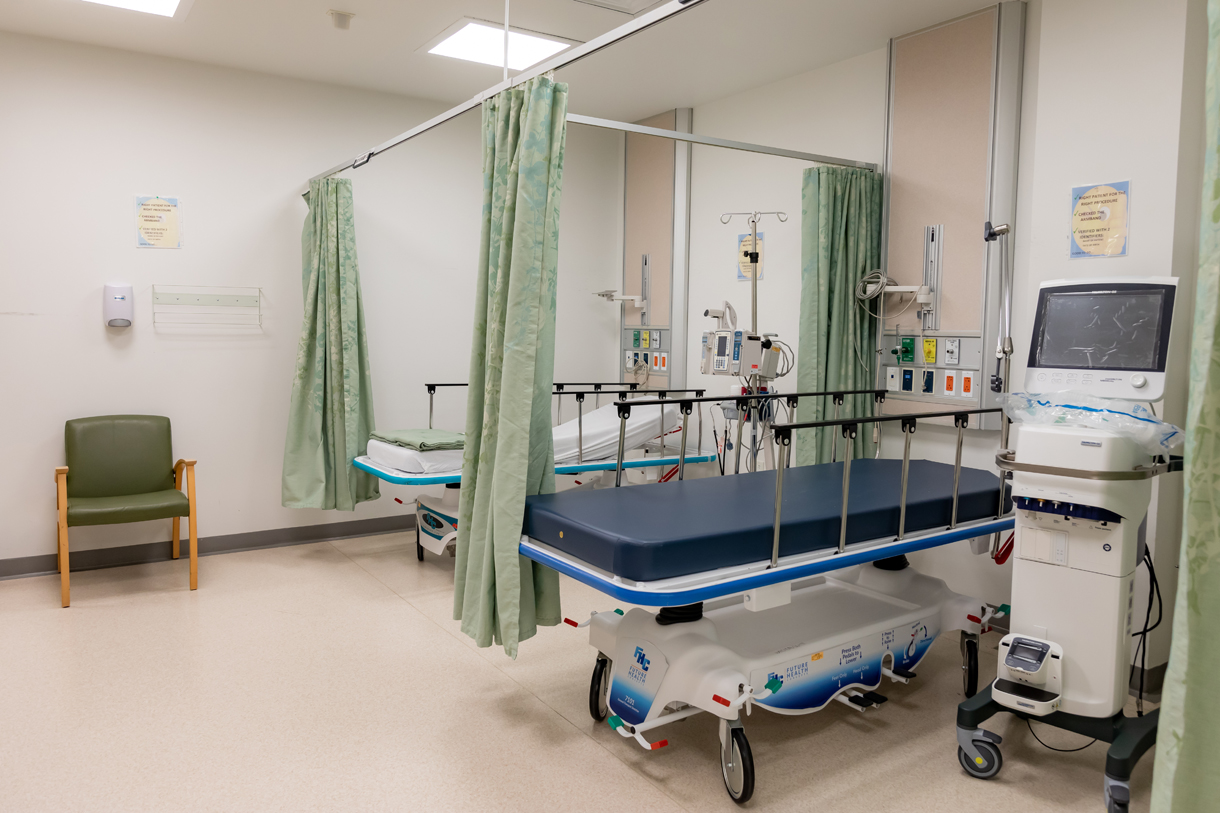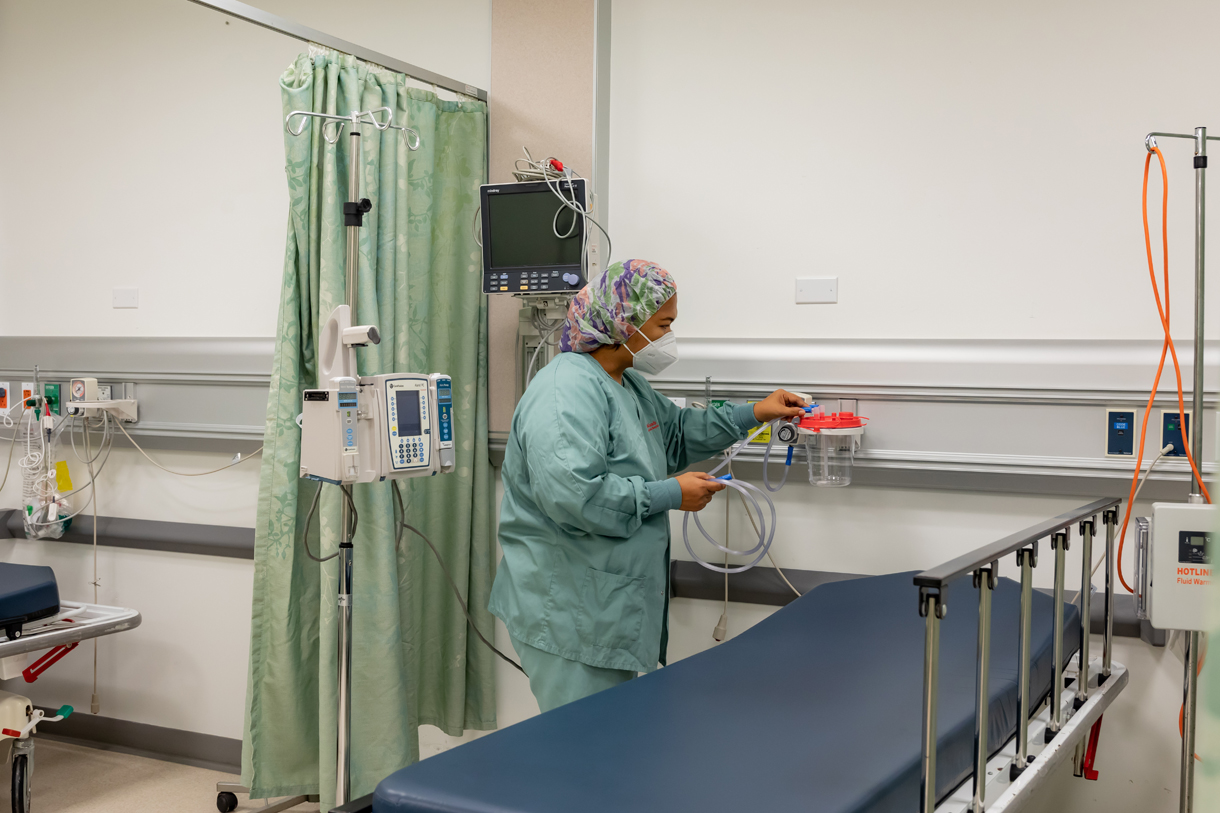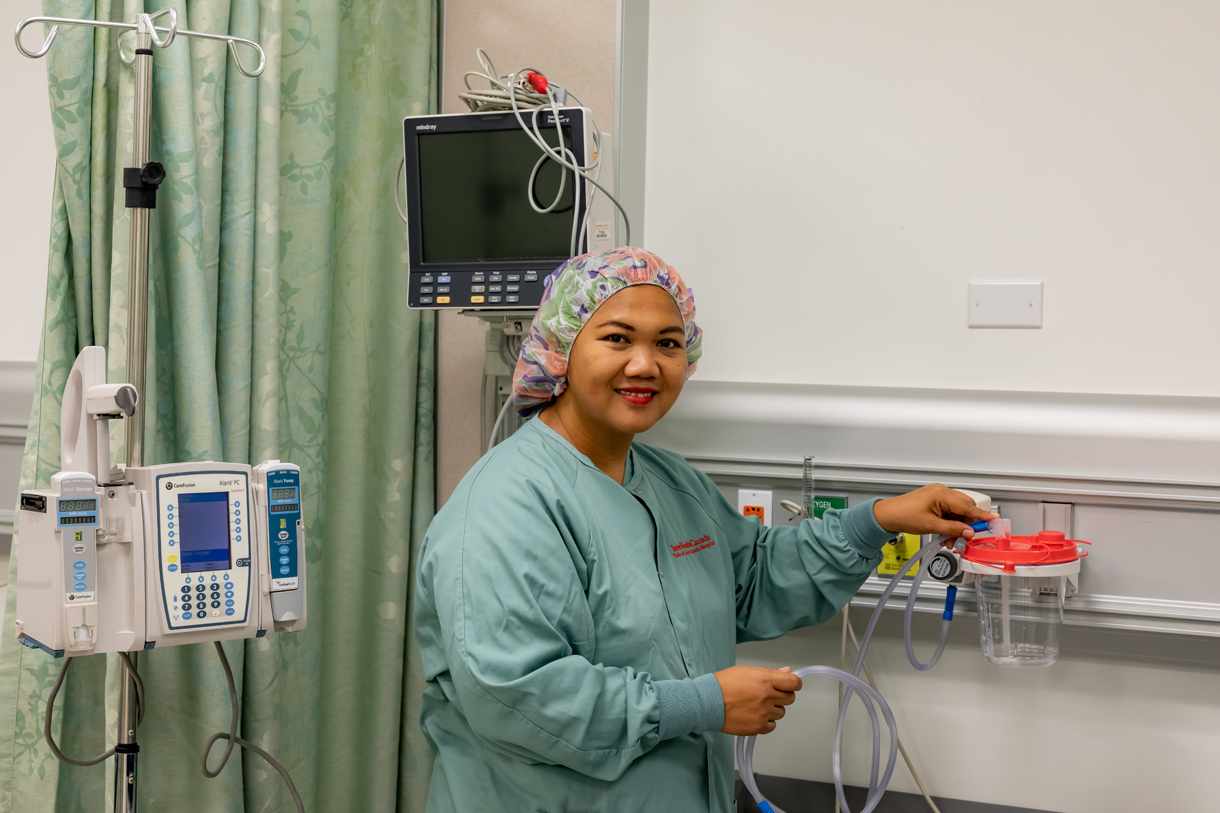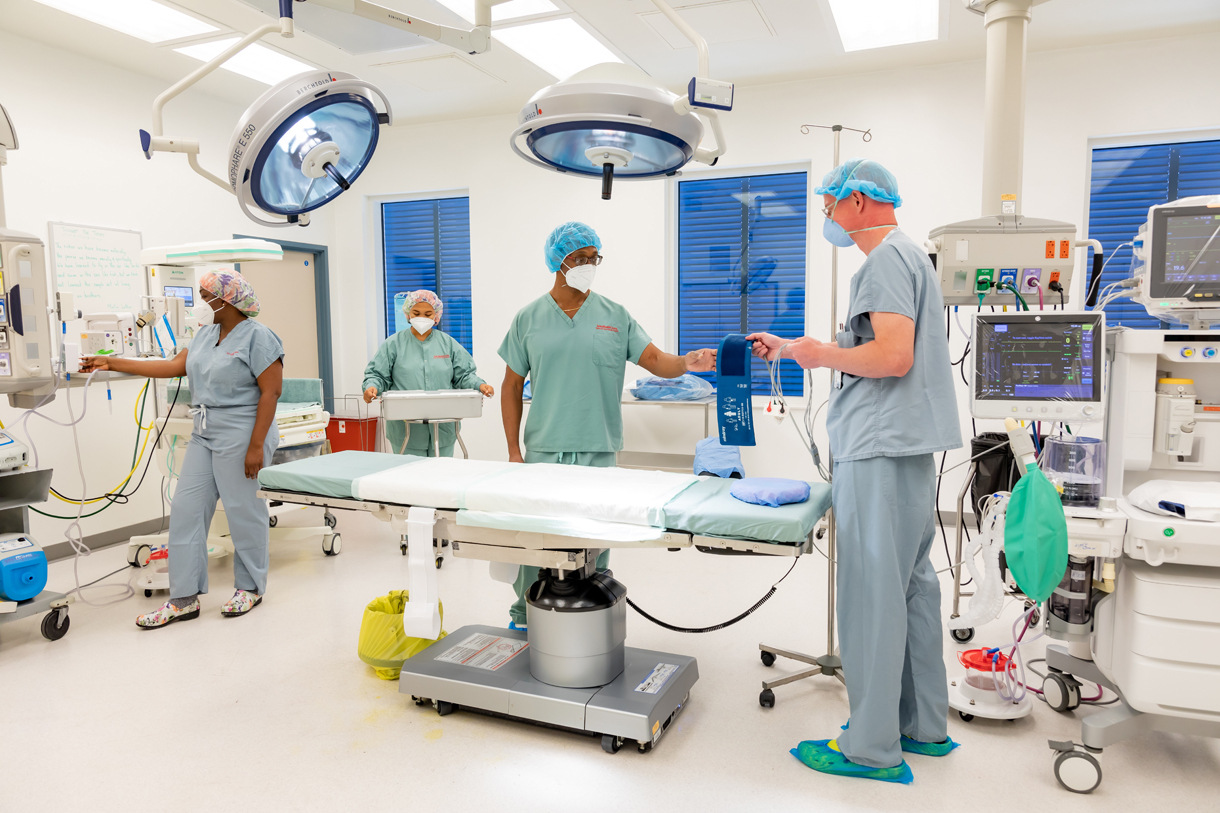Surgical Services caters to the needs of the TCI communities by providing a comprehensive service ranging from diagnostic procedures to treatment and screenings. Specialty areas include Ear, Nose and Throat, Cosmetic and Reconstructive, Ophthalmology, Joint Reconstruction, Arthroscopy and Urology.
Our sophisticated techniques and technology provide ultimate outcomes for all our services in the highest quality environment, most of which are covered by the National Health Insurance Plan.
We engineer and constantly improve our procedures to provide unique treatment options and excellent surgical care.
Surgical Services that we offer
Thousands of surgeries have been performed since the opening of TCI Hospital in April 2010. The measurement of each key performance indicator (KPI) is supported by evidenced-based guidelines. Our KPI for surgical site Infection is measured based on a performance level of 2%. Considering the thousands of surgeries performed, the surgical department has consistently maintained KPI’s between 1.5% – 1.9%. Below is a list of surgical operations offered at TCI Hospital.
Gynaecology Surgery: including Colposcopy, Cryotherapy, Staging Laparotomy, Hysteroscopy; Laparoscopic procedures including: Myomectomy, Hysterectomy, Tubal Ligation, Ovarian Cyst Removal
Obstetrics
Gastroenterology: includes Colonoscopy , Gastroscopy, Biopsy, Polypectomy
Plastic Surgery: includes Brachioplasty, Breast Augmentation, Breast Reduction, Mastopexy, Liposuction, Fat Grafting, Abdominoplasty, Blepharoplasty, Keloid Skin Revision, Skin Grafting, Rhinoplasty, Brow Lift, Facelift, Biopsy.
Otolaryngology (Ear, Nose Throat) Surgery: includes Tonsillectomy, Adenoidectomy, Myringotomy, Septoplasty, Sinus Surgery, Laryngoscopy, Biopsies.
Orthopaedic Surgery: includes Trauma, Adult Reconstruction Joint Arthroplasty-hip, knee, shoulder, Arthroscopy – hip, knee and shoulder.
General Surgery: includes Lumpectomy, Skin Grafting, Thyroid Surgery, Hemorrhoidectomy, Biopsy – Breast, Skin; Circumcision, Mastectomy, Varicose Veins and complete care of the critically ill.
Minimally Invasive Surgery: Laparoscopic hernia repair, appendectomy, cholecystectomy.
Urology Surgery: includes Flexible Cystoscopy, Stent Insertion and Removal, Biopsy.
Anaesthesiology: includes pain management.
Ophthalmology Surgery: including Cataract Removal, Pterygium Excision, Enucleation, Treatment of Diabetic Eye Disease, Retina Services.
Medical Device Reprocessing
The Medical Device Reprocessing Department of the Turks and Caicos Islands Hospital was established to centralize the decontamination, assembly, sterilization, distribution and control of sterile items and equipment throughout the hospital. By assuming total responsibilities for reprocessing all reusable items and equipment it provides more effective, efficient, safer and controlled services.
The role of the Medical Device Reprocessing Department serves as a resource to set the standard for patient safety by maintaining quality aseptic control procedures in a continuing effort to prevent and control the spread of infection.
The Medical Device Reprocessing Department Technicians are certified through the International Association of Healthcare Central Service Material Management (IAHCSMM).
Tests & Visits Before Surgery
These other tests may include:
• Tests that look at the lining of your bowels or stomach, such as a colonoscopy or upper endoscopy
• Heart stress test or other heart tests
• Lung function tests
• Imaging tests, such as an MRI scan, CT scan, or ultrasound test
Make sure the doctors who do your pre-op tests send the results to your surgeon. This helps keep your surgery from being delayed.
Please do try to attend your scheduled pre– op clinic visits. Take with you all medications that you are presently taking, including those prescribed recently and all vitamins. This visit helps to ensure that you have a safe surgery and optimal recovery.
For more information contact 941 – 2800, Ext: 70633: Mon. – Fri. → 8:30am – 5:00pm or Emergency Department – EXT 70408 After 5:00pm, Weekends and Public Holidays.
.
WHAT IS ARTHROSCOPY?
Arthroscopy is a procedure that orthopaedic surgeons use to inspect, diagnose, and repair problems inside a joint. The word arthroscopy comes from two Greek words, "arthro" (joint) and "skopein" (to look). The term literally means "to look within the joint."
During shoulder arthroscopy, your surgeon inserts a small camera, called an arthroscope, into your shoulder joint. The camera displays pictures on a television screen, and your surgeon uses these images to guide miniature surgical instruments.
Due to the thinness of the arthroscope and surgical instruments, your surgeon can use very small incisions (cuts), rather than the larger incision needed for standard, open surgery. This results in less pain for patients, and shortens the time it takes to recover and return to favorite activities.
Shoulder arthroscopy has been performed since the 1970s. It has made diagnosis, treatment, and recovery from surgery easier and faster than was once thought possible. Improvements to shoulder arthroscopy occur every year as new instruments and techniques are developed.
Anatomy
Your shoulder is a complex joint that is capable of more motion than any other joint in your body. It is made up of three bones: your upper arm bone (humerus), your shoulder blade (scapula), and your collarbone (clavicle).
Ball and socket - The head of your upper arm bone fits into a rounded socket in your shoulder blade. This socket is called the glenoid. A slippery tissue called articular cartilage covers the surface of the ball and the socket. It creates a smooth, frictionless surface that helps the bones glide easily across each other.
The glenoid is ringed by strong fibrous cartilage called the labrum. The labrum forms a gasket around the socket, adds stability, and cushions the joint.
Shoulder capsule - The joint is surrounded by bands of tissue called ligaments. They form a capsule that holds the joint together. The undersurface of the capsule is lined by a thin membrane called the synovium. It produces synovial fluid that lubricates the shoulder joint.
Rotator cuff - Four tendons surround the shoulder capsule and help keep your arm bone centered in your shoulder socket. This thick tendon material is called the rotator cuff. The cuff covers the head of the humerus and attaches it to your shoulder blade.
Bursa - There is a lubricating sac called a bursa between the rotator cuff and the bone on top of your shoulder (acromion). The bursa helps the rotator cuff tendons glide smoothly when you move your arm.
Normally, all of these components work in harmony. Disease or injury can disrupt this harmony, resulting in pain, muscle weakness, and reduced function.
When Shoulder Arthroscopy is Recommended
Your doctor may recommend shoulder arthroscopy if you have a painful condition that does not respond to nonsurgical treatment. Nonsurgical treatment includes rest, physical therapy, and medications or injections that can reduce inflammation. Inflammation is one of your body's normal reactions to injury or disease. In an injured or diseased shoulder joint, inflammation causes swelling, pain, and stiffness.
Injury, overuse, and age-related wear and tear are responsible for most shoulder problems. Shoulder arthroscopy may relieve painful symptoms of many problems that damage the rotator cuff tendons, labrum, articular cartilage, and other soft tissues surrounding the joint.
Common arthroscopic procedures include:
• Rotator cuff repair
• Bone spur removal
• Removal or repair of the labrum
• Repair of ligaments
• Removal of inflamed tissue or loose cartilage
• Repair for recurrent shoulder dislocation
Less common procedures such as nerve release, fracture repair, and cyst excision can also be performed using an arthroscope. Some surgical procedures, such as shoulder replacement, still require open surgery with more extensive incisions.
Planning Your Surgery
Your orthopaedic surgeon may ask you to see your primary doctor to make sure that you do not have any medical problems that need to be addressed before your surgery. Blood tests, an electrocardiogram, or chest x-ray may be needed to safely perform your surgery.
If you have certain health risks, a more extensive evaluation may be necessary before your surgery. Be sure to inform your orthopaedic surgeon of any medications or supplements that you take. You may need to stop taking some of these prior to surgery.
If you are generally healthy, your arthroscopy will most likely be performed as an outpatient. This means you will not need to stay overnight at the hospital.
Before the operation, a member of the anesthesia staff will talk with you about anesthesia options. Shoulder arthroscopy is most commonly performed using regional nerve blocks which numb your shoulder and arm. This numbing medicine is injected in the base of your neck or high on your shoulder. This is where the nerves that control feeling in your shoulder and arm are located.
In addition to its use as an anesthetic during surgery, a nerve block will help control pain for a few hours after the surgery is completed. Many surgeons combine nerve blocks with sedation or a light general anesthetic because patients can become uncomfortable staying in one position for the length of time needed to complete the surgery.
Most arthroscopic procedures take less than an hour, however, the length of your surgery will depend on what your surgeon finds and what repairs are required.
Source: Global Med Choices.
CESAREAN SECTION
At the hospital:
•A member of the nursing staff will ‘clip’ any excess hair that I may have at the operative site (where I will receive my incision).
• A tube (catheter) will be placed into my bladder to collect urine.
• Intravenous (IV) lines will be placed in my hand or arm to provide fluid and medication.
• Anesthesia: most planned Cesarean sections are done under spinal anesthesia. I will receive an injection in my spine which numbs only the lower part of my body– allowing me to remain awake during the procedure. I will feel movement as the surgeon gently removes the baby.
With general anesthesia, I will not be able to see, feel or hear anything during the birth.
***I will be able to speak with the anesthetist before I go in for surgery.
WHAT HAPPENS AFTER MY SURGERY?
My baby will be taken to the NURSERY after delivery so that it can be weighed and prepared for my hugs and kisses.
After my surgery, I will be taken to the Post Anesthesia Care Unit (PACU).
• I will be closely monitored by the nursing staff and remain there until I am stable. The amount of time spent in the PACU depends on my progress and on the type of anesthesia I received, as compared to a vaginal delivery.
• I will be encouraged to start breastfeeding as soon as possible when I return to the ward.
• Soon after my surgery, I will be walking and moving around to help speed up my recovery and prevent constipation and dangerous blood clots.
• Discomfort near the incision site can make breast– feeding somewhat awkward. The nurses will be helping & teaching me to position my baby so that I am comfortable.
I have been prescribed pain medication which the nurses will ensure that I receive on time.
• I should keep my dressings dry and clean until my surgeon takes a look at my incision. I will receive further instructions before I go home.
PLEASE CONTACT US AT :
CHMC: 941 – 2800, Ext: 70633:
Mon. – Fri. → 8:30am – 5:00pm or
Emergency Department – EXT 70408 After 5:00pm, weekend and Public Holidays
CTMC: 941– 2900, Ext: 60626: Mon.– 8:00am– 3:00pm & Thurs.- 08:00– 3:00pm or Emergency Department—EXT 60400 After 3:00pm, weekend and Public Holidays.
Having my Circumcision
After surgery I will be taken to the Post Anesthesia Care Unit (PACU).
-- I will be closely monitored by the nursing staff and remain there until I am stable. The amount of time spent in the PACU depends on my progress and on the type of anesthesia I received.
-- I must make arrangements for a family member or friend to be with me upon discharge.
-- I may experience pain at the site; medication is prescribed and I should take as directed.
-- It usually takes about 7– 10 days for the penis to heal.
-- The tip of the penis is likely to be sore at first, and the penis might look red, swollen or bruised.
-- It’s Ok to wipe the penis as it heals. For the child, wipe the tip gently with each diaper change and apply the prescribed ointment to the tip of the penis. Make sure the diaper is loosely fastened.
-- Contact the hospital if:
• normal urination doesn’t resume within 6-12 hours after surgery
• There is persistent bleeding
• There is a bad odor and drainage from the tip of the penis
PLEASE CONTACT US AT :
CHMC: 941 – 2800, Ext: 70633:
Mon. – Fri. → 8:30am – 5:00pm or
Emergency Department – EXT 70408 After 5:00pm, weekend and Public Holidays
CTMC: 941– 2900, Ext: 60626: Mon.– 8:00am– 3:00pm & Thurs.- 08:00– 3:00pm or Emergency Department—EXT 60400 After 3:00pm, weekend and Public Holidays.
Endoscopy Patient Preparation
General Instructions
If you normally take prescription medications, speak to your doctor to see if you should continue taking them before the procedure.
Your last solid meal is your breakfast the day before the procedure.
If you are taking medications such as Aspirin, Motrin, Coumadin (Warfarin), Plavix- please stop at least two (2) days before the procedure.
Gastroscopy
- Have a normal diet the day before the procedure. Avoid liquids with red dyes. NO RED BULL.
- Then NOTHING more to drink or eat after 1000 pm the night before the procedure.
- Remember NOTHING to drink or eat on the morning of the procedure, just report to the hospital and we will assist you from there.
Colonoscopy
Bowel clean-out start at home prior to arrival at hospital for your procedure!
- Stop taking fibre supplements at least 3 days before the procedure such as (Metamucil, Flax seeds, bran etc.)
- Your last solid meal is your breakfast the day before the procedure.
- Drink ONLY clear fluids for the rest of the day such as (soup- broth, apple juice, water, Gatorade). Avoid liquids with red dyes. NO RED BULL.
- Take all the medications as prescribed, starting as precribed the day before the procedure.
- Drink at least 3 more glasses of water throughout the day in addition to other clear fluids. Drink as much clear liquid as you need to stay hydrated.
- Stay close to the bathroom as you will need to use the bathroom frequently.
- Remember- take all the medications as prescribed at the times explained to you.
- Continue to have clear fluids only, then NOTHING more to drink after 1200am the night before the procedure.
- Remember NOTHING to drink or eat on the morning of the procedure, just report to the hospital and we will assist you from there.
LAPAROSCOPIC HERNIA REPAIR
Laparoscopic surgery can be used for hernia repair. Instead of one long incision, four or five tiny incisions are made in the area around the hernia. A device called a laparoscope, which is a miniature scope attached to a video camera, is inserted into one of the incisions. The surgeon is able to see the hernia and the surrounding tissue and organs on a video screen.
Advantages of this technique include shorter recovery time and less postoperative pain.
HOW IS MY HERNIA FIXED?
Surgery proceeds in much the same way, regardless of where the incision is made. The hernia sac is carefully opened and the intestine or other tissue is placed back inside the abdomen. The weakened area is repaired and reinforced with a synthetic mesh or a suture that pulls the abdominal muscle tissue back together.
The entire procedure takes about 1 hour in adults and 45 minutes in children.
WHAT HAPPENS AFTER MY SURGERY?
After hernia repair surgery, I will be taken to the Post Anesthesia Care Unit (PACU).
- I will be closely monitored by the nursing staff and remain there until I am stable. The amount of time spent in the PACU depends on my progress and on the type of anesthesia I received.
- Inpatients return to their room. Most patients go home once they are up and walking around.
I must make arrangements for a family member or friend to be with me upon discharge, if I am going home the day of surgery.
- I may experience pain at the incision site; medication is prescribed and I should take as directed.
- Swelling and discoloration usually develops around the incision and eventually disappears in the healing process. Some soreness can be expected during the first 24 to 48 hours.
- The wound must be kept dry until it begins to heal.
- Straining during a bowel movement also puts strain on the incision. It is therefore important that I eat a high-fiber diet and drink plenty of fluids to avoid constipation.
PLEASE CONTACT US AT
CHMC: 941 – 2800, Ext: 70633:
Mon. – Fri. → 8:30am – 5:00pm or
Emergency Department – EXT 70408 After 5:00pm, weekend and Public Holidays
CTMC: 941– 2900, Ext: 60626: Mon.– 8:00am– 3:00pm & Thurs.- 08:00– 3:00pm or Emergency Department—EXT 60400 After 3:00pm, weekend and Public Holidays
Methicillin Resistant Staphylococcus aureus (MRSA)
Information for Patients
General information:
Staphylococcus aureus (Staf-lo-coc-cus aw-ree-us (staph) is a germ that often lives in the nose and on the skin of healthy people and spreads from person to person on contaminated hands, skin, objects and through a contaminated environment.
Most infections caused by “Staph” are skin infections, but this germ can also cause more serious infections such as blood and joint infections and pneumonia.
A type of Staphylococcus Aureus called MRSA (Methicillin Resistant Staph aureus) cannot be destroyed by certain antibiotics like penicillin because they have developed resistance to them. These antibiotics are the ones which are most commonly used to treat this infection.
How to Prevent Staph Skin Infections:
Keep your hands clean. Wash hands well with soap and water or by using an alcohol hand gel.
Keep cuts and scrapes clean and covered with a bandage until healed.
Avoid contact with other people’s wounds or bandages.
Avoid sharing personal items such as towels or razors.
What to do if you have a Staph Skin Infection:
Cover your wound. Keep wounds that are draining or have pus covered with clean, dry bandages. Follow your healthcare provider’s instructions on proper care of the wound. Pus from infected wounds can contain staph.
Keeping the infected wounds covered will help prevent the spread to others. Bandages or tape can be thrown away with the regular trash.
Wash your hands. You, your family, and others in close contact should wash their hands often with soap and warm water. You can use an alcohol hand gel when soap and water are not available. This is especially important to do after changing the bandage or touching the infected wound.
Do not share personal items. Avoid sharing personal items such as towels, washcloths, razors, clothing, or uniforms that may have had contact with the infected wound or bandage. Wash soiled sheets, towels, and clothes with hot water and laundry detergent. This also helps kill bacteria in clothes.
Talk to your doctor. It is important to tell any healthcare providers who treat you that you have or had a staph or MRSA infection.
What does a Staph or MRSA Infection Look Like?
Staph bacteria, including MRSA, can cause skin infections that may look like a pimple or boil and can be red, swollen, painful, or have pus or other drainage.
More serious infections may cause pneumonia, bloodstream infections, or surgical wound infections.
What factors are associated with Increased Risk for Community-Associated Staph or MRSA Infections?
Factors that have been associated with the spread of MRSA skin infections include: close skin-to-skin contact, openings in the skin such as cuts or abrasions, contaminated items and surfaces, crowded living conditions, and poor hygiene.
MRSA infections can be common in some hospitals and other healthcare settings, like dialysis centers or nursing homes, but it is NOT common inside Turks and Caicos Islands hospitals.
All patients who need to be admitted to stay in our wards are screened by taking swabs from the nose, under the arm and between the legs. Special precautions will be taken if this germ is detected to stop it spreading to other patients.
As germs are spread easily on hands it is necessary to indicate to all staff that special precautions are in place by placing a sign on the door to the patients room which states:
CONTACT PRECAUTIONS
This tells all the health care staff (Doctors, Nurses, Porters, and Housekeepers) that they must follow precautions before entering and after leaving to ensure any infection is not spread. However, MRSA is often brought into the hospital environment from the home and community and recently MRSA infections have been found in healthy people outside of the hospital.
Most of these MRSA infections are found in the skin and soft-tissue (muscle or fat) and most often are seen as abscesses.
Since they occur in people in the community, they are referred to as community-associated MRSA (or CAMRSA) infections.
CAMRSA is clinically and genetically different from MRSA infections that people acquire in healthcare settings. The information below should help consumers and healthcare professionals understand CAMRSA as a new and emerging disease.
Smoking & Surgery
Most doctors will tell you to stop using cigarettes and tobacco at least 4 days before your surgery.
Stretching the time between quitting smoking and your surgery out to at least 2 weeks can decrease your risk of problems even more.
Like any addiction, quitting tobacco is difficult, especially if you are acting alone. But there are many ways to quit smoking and many resources to help you:
Family members, friends, and coworkers may be supportive or encouraging.







